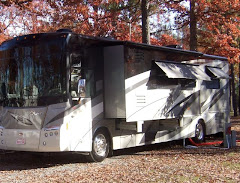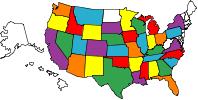
One of the tools we use to determine places to explore is the book "1,000 Places to See in the U.S. and Canada Before You Die." Actually, I am notorious for checking the book just after we've left a part of the country where several places are listed in the book. With a few days between service appointments in Iowa, we consulted the book, which pointed us to the Amana Colonies, just west of Iowa City.
The Amana Colonies, a National Historic Landmark, is a group of seven villages covering some 26,000 acres along the Iowa River. The villages, which are all no farther apart than an hour's drive by oxcart, were founded in the mid-19th Century by the Community of True Inspiration, a German religious society that came to America to escape persecution. They named their community Amana, which in the Song Of Soloman means "to remain true." For nearly 80 years, the communal villages thrived in a self-sufficient manor. Each of the villages had a main street for shops. In the village of High Amana, today the original general store is run by the Amana Society, the corporate heir to the land and economic assets of communal Amana.
We started our 17-mile loop tour of the colonies in High Amana, where a lovely woman behind the counter in the village store gave us a most informative introduction to the history of this unique community. We were so grateful for her introduction, because most of the museums around the colonies are not yet open for the season. We're here before things really get "cooking" in Amana.

Our friendly "guide" pointed across the street from the store to this house and explained its significance to the colonies. In the 1930s, this was the place where a couple of locals put their heads together to build a beverage cooler for the store.

That modest effort was the start of Amana Refrigeration. It was here, in 1947, that the first upright home freezer was manufactured. The first side-by-side refrigerator freezer came a couple of years later. Since then, this factory has churned out air conditioners and microwaves, and has served as a major employer in the area. Today, Amana is a division of Whirlpool.

The village of West Amana is home to the Schanz Broom and Basket Shop, which showcases the work of local craft artisans. Next door is the Giant Rocker, which is billed as Iowa's Largest Solid Wood Rocker. At over 11 feet tall and weighing in at 650 pounds, we won't dispute that claim! The chair was constructed by Schanz Family woodworkers at their furniture workshop in South Amana.

We enjoyed lunch at Ronneburg Restaurant in Amana, the largest of the seven villages. The building originally served as one of the Amana Colonies' communal kitchens. Every home in the colonies was assigned to a kitchen where they would receive their daily meals. The neighborhood women worked under the direction of the kitchen boss to cook, garden, serve and clean. Men ate at one table, and women and children ate at another. Fifteen minutes were allowed for each meal period. No conversation was allowed and music was strictly forbidden. Modern day diners can take their time enjoying tasty German food over welcome conversation and pleasant background music.

We got another taste of early Amana dining this morning at the Colony Inn Restaurant. Originally known as the Amana Hotel, this building has welcomed visitors since 1860. The simple interior and tasty family-style breakfast made it easy to imagine life in early Amana.

The architecture throughout the colonies is simple. Many original homes and buildings are constructed of native limestone.

Others structures are made of brick, many of which are adorned with trellises. In several weeks, the front of this home will be covered in ivy. If you're looking for a church in Amana, they are easy to miss. Located in the center of each village, the simple structures are made of stone or brick, have no steeple or stained glass windows. (I thought I took a picture of one, but now I'm not sure!)

Several businesses that originated to serve the self-sufficient, communal colonies continue today as commercial concerns. At the Amana Woolen Mill, visitors can watch looms in action. The pieces produced here are known for their high quality.

In addition to lovely blankets and other woolen goods, these colorful spindle-ends of yarn are available for sale.

Residents have also established several "modern-day" businesses. Of course, I had to check out Heritage Designs Quilting and Needlework. This lovely family-owned shop has been in business since 1976, and has been recognized as one of the top 10 quilt shops in the country. A quilter could get lost in here! And, if you can find your way out of this shop, there's another quilt shop in South Amana!

We included a bit of geocaching in our visit to the colonies. As always, our treasure hunting brought us to some interesting sites a bit off the beaten path, like the Amana train depot. The depot is the trailhead for the Kolonieweg, a 3.1-mile trail connecting the villages of Amana and Middle Amana.

Today the Amana Colonies offer everything a 21st century visitor could want, including a large RV park, which is owned and operated by the Amana Society. The park is large, level, grassy, treeless and very spacious this time of year.

No, our moose didn't make this mess. These are two of the back tires of a motorhome that plowed its way into a spot late the other night in the middle of a rainstorm. We heard spinning wheels and a diesel engine whining. It didn't sound good, and it wasn't. The next morning, this rig had to be pulled out of some mighty muddy ruts.

This afternoon we enjoyed a very pleasant geocaching walk around Lily Lake. As we were nearing the completion of the loop, we noticed this cheerful message painted on the trail in front of Amana Elementary School. It seemed a fitting way to wrap up our visit in this lovely community.
Tomorrow, we're off to Forest City. It's not listed in the 1,000 Places book. But, if you want to get a Winnebago fixed, it's the place to go. Here's hoping it's a happy trail, indeed!






No comments:
Post a Comment